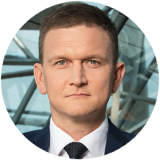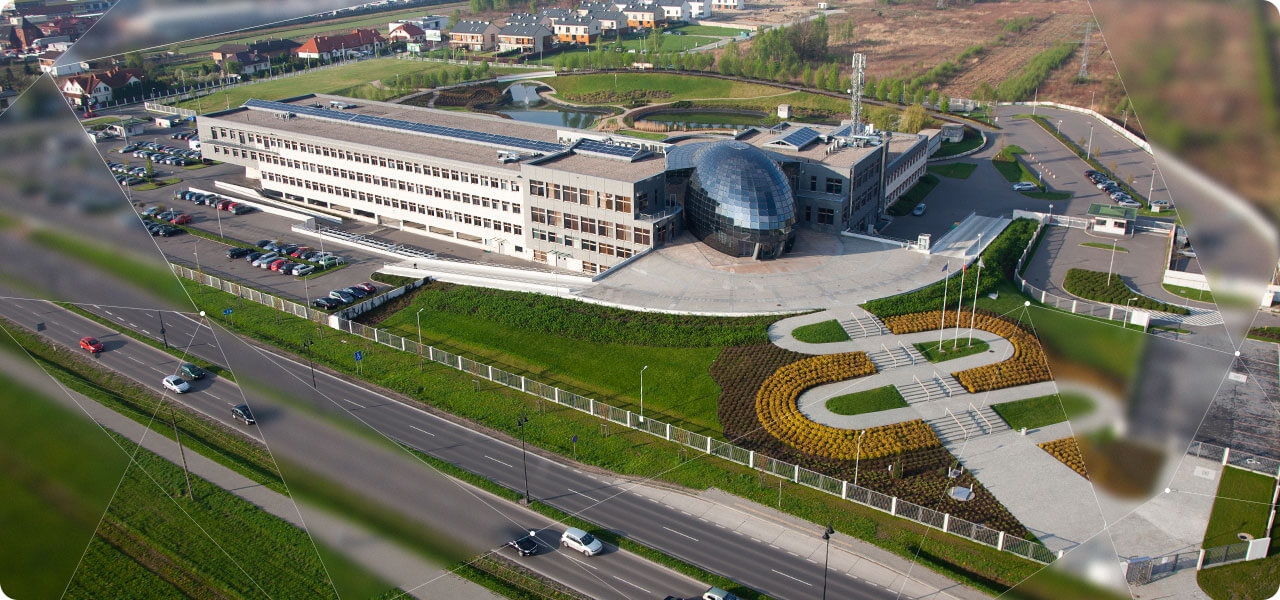Recipients:

Central administration, regulator

Participants of the electricity market

Contractors and subcontractors

Investment environment

Industry organisations

Scientific and research institutions

Employees and potential employees

Media
Corporate governance and ethics
PSE is a sole shareholder company of the State Treasury, operating in the form of a joint-stock company with its headquarters at Warszawska 165, 05-520 Konstancin-Jeziorna. The company has been operating as an independent transmission system operator already for 14 years.
Authorities of the company
GRI 102-5 The sole shareholder of PSE is the State Treasury whose powers are exercised by the Government Plenipotentiary for Strategic Energy Infrastructure at the Ministry of Energy.
GRI 102-18 GRI 102-22 Corporate oversight over the company's activities is exercised by the Supervisory Board. The Members of the Supervisory Board are appointed for the 3-year term of office by the General Meeting acting through the Government Plenipotentiary for Strategic Energy Infrastructure.
The SB acts on the basis of the Commercial Companies Code and other provisions of law, the Company’s Articles of Association, EGM resolutions and SB By-Laws it adopts.
The competence of the Minister of Energy covers matters related to energy security of the country, including the security of energy supply, energy resources and fuels, as well as energy infrastructure - the operation of power systems, in line with the principles of rational economy and the needs of the country’s energy security.
Composition of the Supervisory Board
as at the date of the report
(skip toGlossary)
Paweł Łatacz
Chairman of the Supervisory Board
Adam Piotrowski
Deputy Chairman of the Supervisory Board
Marcin Czupryna
Secretary of the Supervisory Board
Rafał Gawin
Member of the Supervisory Board
Zbigniew Kochański
Member of the Supervisory Board
Ksenia Ludwiniak
Member of the Supervisory Board
Changes to the Supervisory Board
The Audit Committee (AC) was set up by the SB on 31 January 2017 by its resolution No 1/V/2017. It is composed of at least three members appointed by the SB for the term of its office from among its members.
The AC supports the SB in particular in the oversight of the following:
- implementation and control of the financial reporting processes in the company and its capital group,
- functioning of the internal control systems in the company,
- functioning of the risk identification and management systems,
- independence of internal and external auditors,
- company’s relations with related entities in the meaning of the Accounting Act of 29 September 1994.
The By-Laws of the AC is adopted by the SB and approved by the GM.
The Investment Committee (IC) was established by the SB on 28 September 2018 by Resolution No 55/V/2017. It is composed of at least three members appointed by the SB for the term of its office from among its members.
The Investment Committee supports the Supervisory Board in the oversight of:
- implementation of the Company’s plan of investment projects,
- transmission network planning.
Composition of the Management Board
as at the date of the report
(skip toGlossary)

Eryk Kłossowski
President of the Management Board

Jarosław Brysiewicz
Vice-President of the Management Board

Jakub Kozera
Vice-President of the Management Board

Włodzimierz Mucha
Vice-President of the Management Board

Tomasz Sikorski
Vice-President of the Management Board
The management Board of PSE manages its affairs and represents it in all judicial and non-judicial proceedings. The Members of the Management Board are appointed for the 3-year term of office by the GM or the SB.
The Management Board acts on the basis of the Commercial Companies Code and other provisions of law, the Company’s Articles of Association, GM resolutions and Management Board By-Laws adopted by the Management Board and approved by the SB.
Changes in the Management Board
PSE Organisational Structure
as at the report date
GRI 102-18
(skip toGlossary)
Central Investment Unit
Management Board Department
Security Department
ICT Department
Communication Department
Risk Management Office
Legal Office
Supervision Office
Work Environment Management Office
Maintainance Department
Technical Standards Department
Human Resource Management Department
Purchasing Department
Planning and Controlling Department
Accounting and Finance Department
Administration Department
System Development Department
System Operation Department
Transmission Department
International Cooperation Department
Energy Metering Office
Fig. 1. PSE Organisational chart
PSE Management Board
|
PRESIDENT OF THE MANAGEMENT BOARD |
MEMBER OF THE MANAGEMENT BOARD |
MEMBER OF THE MANAGEMENT BOARD |
MEMBER OF THE MANAGEMENT BOARD |
MEMBER OF THE MANAGEMENT BOARD |
|---|---|---|---|---|
| Eryk Kłossowski Supervised OUs: |
Jarosław Brysiewicz |
Jakub Kozera |
Włodzimierz Mucha |
Tomasz Sikorski |
Central Investment Unit Management Board Department Security Department ICT Department Communication Department Risk Management Office Legal Office Supervision Office Working Environment Management Office |
Maintenance Department |
Human Resource Management Department |
System Development Department |
Transmission Department |
Fig. 1. Division of tasks
The Management Board, indicating the scope of rights and responsibilities, establishes committees for carrying out regular surveillance and coordination of activities in the areas of particular importance for the company. The committees, as opinion-giving, advisory and decision-making bodies, support the Management Board in the set areas. They are composed of the members of the Management Board competent for a given area and heading the units as well as experts in the subject matters dealt with by a given committee.
- Investment Committee - the area of investment process management at the PSE CG (the chairman of the committee is the President of the Management Board of the company);
- Standardisation Committee - the area of approving the technical and technological standards in force at the PSE CG (the chairman of the committee is the Vice-President of the Management Board supervising the unit responsible for determining the aforementioned standards);
- Security Committee - the area of maintaining and improving physical security at the PSE CG (the chairman of the committee is the President of the Management Board);
- Data Governance Committee - the area of data management (the chairman of the committee is the President of the Management Board);
- GRI 103-2 Innovation Committee - the area of adequacy and continuity of implementation of R&D projects (the chairman of the committee is the Vice-President of the Management Board supervising the unit responsible for innovations);
- REMIT Committee - the area of coordination of the implementation of obligations resulting from the REMIT Regulation (the chairman of the committee is the Vice-President of the Management Board supervising the unit responsible for communication);
- Network Codes Implementation Committee - the area of transposition to the Polish legal order the Network Codes and Guidelines - regulations issued pursuant to Art. 6 and 18 of the Regulation (EC) No 714/2009 of the European Parliament and of the Council of 13 July 2009 on conditions for access to the network for cross-border exchanges in electricity (the chairman of the committee is the Vice-President of the Management Board supervising the unit responsible for international cooperation);
- Social Activities Committee - the area of corporate social responsibility at PSE CG (the chairman of the committee is the Vice-President of the Management Board).
- GRI 103-2 Cyber Security Committee - the area of coordinating ICT and cyber security at the PSE CG (the chairman of the committee is the President of the Management Board).
GRI 102-18 GRI 102-20 There are special functions appointed at the company for the performance of specific tasks. Most of them results from the requirements of relevant standards.

System Compliance
GRI 102-17 GRI 103-1 Our company has implemented a compliance system aimed at ensuring the compliance of the Company's operations with law provisions, internal regulations and ethical standards. One of the main functions of compliance is supporting the protection of the company, its employees and management bodies against threats in terms of reputation, conflict of interest or protection of market participants.
In 2017 we carried out 12 training courses on compliance. They focused on:
- Responsibility, including non-abuse of a dominant position
- ethics
- corruption and gifts
- conflict of interests
- reputation and cooperation with business partners
- cooperation with regulators
- mobbing and labour rights
- Remit
- personal data protection.
In 2017, within the framework of education in the area of compliance, we also carried out on-line training, which covered the publication of information materials in the internal network of PSE. The subject of these trainings was conflict of interest and gift policy at PSE CG. We have also started the publication of educational materials in the form of a new column, which has become a permanent position on the pages of the "Przesył" magazine - a periodic, internal publication of PSE.
For all new employees, we provide the "Compass for start" training program; training is provided by the Compliance Officer, and the respective guidelines are published on the intranet.
GRI 102 -16
PSE vision, mission and value
Reliability, credibility and responsibility are the highest values described in the PSE Strategy; they also form the basis for the newly developed Code of Ethics.
Works on its implementation are being finalized. We worked on the creation of the new Code in employee groups with the participation of representatives of many PSE units. According to the survey conducted among our employees, the key values for the coming years should be: Partnership, Responsibility, Openness, Development and Professionalism.
The new Code of Ethics will be strongly related to HR Policy. Both of these documents intertwine and co-form a framework for the rules of cooperation we want to govern at PSE. Studies show that those who are aware of the company's values and identify with them, become more loyal and integrated with their company. For many years, PSE has paid great attention to the employees' motivation to diligently perform their duties, and also to willingly represent PSE outside.
GRI 406-1
Zero (O)- cases of discrimination in 2017
The employees have the possibility to report any abuses anonymously to the email address of the Compliance Officer provided on the intranet.
Our actions against corrupt behaviour
Our organisation operates the coherent anti-corruption system which comprises two superior documents relating to this area; Anti-corruption Policy and Corruption Risk and Abuse Prevention Procedure.
PSE’s anti-corruption policy constitutes a set of mandatory rules to be followed by the company’s employees, contractors and subcontractors.
The procedure for corruption risk and abuse prevention at PSE presents clear and transparent approach to be followed in the event of the risk of corruption, abuse or potential for a conflict of interests. It is an element of PSE’s business security and aims to provide the employees with the comfort of acting in such situations.

Facts worth knowing
PSE has been audited for the Corruption Risk and Abuse Prevention System Certification.
Following the positive results of the audit, our organization has obtained a certificate attesting compliance with the BS10500 standard, which confirms our high standards regarding anti-corruption activities. The implementation of the Management System based on the provisions of the BS 10500 standard is synonymous with informing other entities operating on the market about the adoption of a policy of zero tolerance for corrupt practices. This has a positive effect on the image of our organization in the environment.
The implementation of anti-corruption policy in our organization is the responsibility of the Management Board’s Representative for Anti-corruption, in cooperation with the Security Department, Supervision Office (Audit) and HR Department.
In the framework of anti-corruption activities, the Security Department supports the Management Board’s Representative for Anti-corruption in the following scope:
- provision - independently or in cooperation with Compliance - of regular trainings on corruption issues for employees of PSE and CJI,
- co-organization of systematic training with CBA experts, aimed at raising legal awareness related to counteracting corruption among PSE and CJI employees,
- coordination of the implementation of the Management Board’s recommendation imposing the obligation to complete the e-learning training provided via the CBA e-learning platform.
The Department of Security regularly analyses the areas of PSE's operations in order to diagnose potential corruption threats to counteract them and publishes (as needed) on intranet sites the educational and legal information for PSE employees. Further tasks of the department include also the monitoring of corruption threats and legal regulations in the field of counteracting corruption crimes.
The activities carried out as part of corruption prevention at PSE are regularly updated, including through continuous reporting and discussing tasks related to counteracting corruption at the meetings of the Management Board and of the Supervisory Board, as well as monitoring of the introduced legal provisions which regulate the status of whistleblowers.
In the nearest future, the following measures will be introduced:
- the requirements to undergo compulsory anti-corruption training for employees of the contractors / subcontractors who carry out PSE investments;
- appropriate provisions in employment contracts for PSE employees, imposing the obligation of active participation in counteracting and combating corruption;
- provisions in contracts with contractors clearly stating that they have received, read and understood the Anti-Corruption Policy applied by PSE and that they will follow it.
Risk Management
GRI 102-15 The Company has implemented or is preparing a number of measures preventing or reducing the effects of risks in various areas.
Failures of substation and line equipment:
- Reduction of the frequency or elimination of failure events of technical character that limit the operational scope of a substation, by implementing the predictive maintenance approach and the reliability based inventory management to the process of replacement and maintenance of the substation infrastructure components and maintaining an adequate inventory level (standard apparatus, devices and other elements of the substation’s equipment);
- Development and implementation of a uniform operation model for all network assets, which allows for carrying out, in a cyclical, standardized and measurable manner, measurements of the technical condition of devices and their work environment, as well as preventive replacement of the most worn-out and oldest elements of network assets;
- Technological standardization of the main classes of technical devices allowing to increase the reliability of the failure probability assessment based on the evaluation of operating parameters (e.g., failure and availability indicators);
- Conclusion of central support and failure management agreements for substation, line and transformer facilities. Parallel implementation of the Maintenance Services Development Programme allowing for continuous improvement of the competences of the company’s own maintenance services, including Network Maintenance Units (ZES) performing field works;
- Investment activities aimed at alleviating overloads of the busiest transmission lines;
- Analysis and modification of the ZES-based operation model and maintenance-free stations in terms of optimization from the point of view of the balance between the cost and safety of the substation's operation (and PPS), including the review of requirements for the occupation rate of the posts at ZES;
- Improving the model of contracting key equipment, especially substation equipment.
Disruption of the investment processes:
- Implementation of absolute requirements for the contractors of investment tasks regarding their financial condition, performance capacity and experience;
- Optimization of routes and locations of network investments aimed at reducing the risk of public protests;
- Agreeing the routes of the transmission lines with the participation of local communities;
- Paying attention to the issues of timely acquisition of legal titles for the use of land property, for which specialized legal services are used.
- Conducting work on a deeper modification of the contracting and investment project management model to improve the efficiency of:
- supervision of contractors,
- control over the quality of supplied equipment and performed works, including the insight into production processes,
- the process related to planning and granting necessary shutdowns of PPS elements.
Power shortages in the PPS:
- Conclusion of contracts for services reducing the consumers’ energy demand (DSR, Demand Side Response), agreeing optimal repair schedules of generating units with manufacturers, concluding contracts for nJWCD availability services, as well as contracts for emergency assistance with neighbouring transmission system operators;
- Maintenance of reserves with the use of the operating power reserve mechanism and the cold intervention reserve;
- Planning and making investments aimed to increase the transmission capacity and improve the security of transmission networks.
Cyber security:
- Technical and organisational solutions based on good practices in cyber security;
- Implementation of the Information Security Management System based on the ISO 27001 standard in the company, supported by the activities of the organisational units responsible for security, technical tools implemented at each level of information processing, and physical protection systems for server rooms, electrical substations and offices;
- Audit and advisory actions taken under the projects, aimed to identify gaps in the protection system in place.
Regulations:
- Continued support provided by PSE for lobbying relating to the legislative works on the “Clean Energy for All Europeans” package;
- In the case of the Capacity Market Act, the analyses carried out by PSE played the key role in the negotiations with the EC, and in the case of the package the company’s actions contributed to the significantly more beneficial for Poland modifications of the provisions of individual legal acts.
Risks of the implementation of the Financial Plan are subject to a special analysis. The key categories are listed below:
Occurrence of extraordinary events
In the situations of unplanned power supply disruptions, in addition to higher costs of the purchase of reliability must run (RMR) services and Cold Intervention Reserve (CIR) as well as the increase in the costs congestion elimination, PSE will be exposed to the risk of bearing the unplanned costs associated with the removal of failure effects and intervention purchase of energy from neighbouring systems.
Serious network or substation failures
A failure of a critical network or substation element may result in the need to bear unplanned costs of purchase and replacement of damaged elements, including the participation of specialised external companies.
Failure of the Poland-Sweden DC interconnection
Failure of the submarine part of the cable will result in the need to bear the costs of repair with the use of a specialised vessel and team.
Investment risks
The delays result, among others, in the costs of taking additional actions of an investment nature (e.g. realignment or extension of the cabling route) and in the area of public communication.
Should any contractor of one large or several investment tasks stop works, PSE must immediately take a number of unscheduled actions the cost of which was not included in the plan (e.g. security of the construction site, storage of materials and apparatus, warranty extension).
Cost elements passed on through the quality fee
The highest uncertainty is associated with the costs of balancing market (BM). The accurate forecast of these costs is difficult as their level is affected by a number of factors which are often intercorrelated: surplus of available power over peak demand, energy prices on the wholesale market, their trend, and variable generation costs.
Increase in the costs of the Inter-TSO Compensation (ITC) mechanism
The result of PSE’s clearing operations under the ITC agreement is difficult to predict, as it depends on many factors beyond the control of PSE: in particular, volumes of cross-border flows on PPS connections with neighbouring systems, cross-border flows across Europe and the impact of cross-border flows on the amount of energy losses in the PPS and in power systems of other TSOs covered by the ITC agreement.
Tools used for risk management
In 2017 PSE adopted the Risk Management Policy. In line with this policy, risk management covers all areas of the company's operations, in particular ensuring continuity of electricity supply, provision of transmission services and implementation of investment processes. The company's strategy for the years 2017-2019 indicates reliability, credibility and responsibility as the highest values on which our organization bases its vision and mission. Ensuring the compliance of PSE's activities with the above values requires, among others, predicting threats and opportunities resulting from events independent of the company, as well as the consequences of consciously made decisions.
Risk management policy is a directional document aimed at coordinating, systematising and unifying the activities undertaken in the company in the area of risk management, which include:
- identification, description and quantitative and qualitative assessment of uncertain events that may have a significant impact on the company's ability to achieve strategic, financial and operational goals and on the company’s reputation,
- selection of methods and tools that reduce the probability of occurrence and/or minimise negative risk effects or increase the probability and maximise and/or maximise positive risk effects,
- maintaining identified risks within acceptable limits, by taking actions which are economically acceptable and take into account the justified level of security of the company's operations.
The risk management methodology defines in particular:
- organisation and manner of carrying out the risk review,
- guidelines for identification, analysis and evaluation of risks as well as the manner of describing them,
- rules for quantification of the probability of occurrence and evaluation of the effects of risks,
- guidelines for risk management, means of identification of risk control methods and tools as well as development of risk management plans and their monitoring.
The risk review is carried out at least once a year, and within its framework a register is prepared that summarizes the risks material to the company and a risk map presenting the identified potential events in a graphical manner.
The identification and assessment process concerns risks, i.e. events or uncertain circumstances, which in case of occurrence will have negative or positive consequences for the company's operations.
The second stage is the preparation and implementation of a risk management plan executed by the different organisational units and the monitoring or its performance. In principle, risk management measures must be economically acceptable and take into account the need to maintain the required level of PSE's operation security.
In 2017, PSE started or planned a range of new measures related to risk management in different business areas.
These measures relate to:
- the development of the methodology and manner of carrying out the criticality/materiality scoring of the PPS infrastructure elements, which has already become a basis for maintenance planning, prioritisation and planning of repairs, including in a multi-annual cycle, and the development of standards for solutions used at electrical substations,
- the development of a new risk management standard for investment contracts, which includes combining contractual sanctions with key needs of our company, performance guarantee, insurance requirements, payment schedule, as well as work progress monitoring methods,
- PPS network operation procedures and tools in the emergency mode,
- analyses and day-to-day monitoring of PSE's financial exposure resulting from the operation of balancing market mechanisms,
- monitoring the risk of PPS imbalance by expanding a tool for the estimation of stochastic operating power reserve launched in 2016,
- developing the SMTA (short and medium term adequacy assessment) tool for the stochastic analysis of sufficiency over the one-week horizon together with the flexibilisation of the tool according to the needs of ENTSO-E.
As of 2018, the implementation of a risk monitoring system based on KRIs (Key Risk Indicators) has been initiated. The KRI analysis provides information on changes and trends (e.g. on the frequency of events and incidents), which will constitute the basis for updating the risk measures.
In risk management, a professional IT tool developed by PSE GC specialists is used, which is regularly upgraded and tailored to current needs.
GRI 102-11We analyse our impact on the natural environment and take measures to reduce negative impact while pursuing initiatives that have a positive impact. Risk management is part of each certified management system in place in our organisation.
Risk map taking into account social and environmental risks
The risk map presents the risk identified in the course of risk review and qualified to be entered in the risk registry. The vertical axis expresses the expected frequency of risk materialisation within a year. The horizontal axis expresses the measure of risk effects with the use of a monetary unit (PLN).
Under the measure of risk we understand the product of the sum of expected frequencies of materialisation of each of the risk’s causes in a year, adjusted by the conditional probability of risk materialisation in case of occurrence of individual causes, and of the total value of direct and indirect effects of its materialisation. The individual risks are presented on the map in the form of pie charts where the diameter of the circle indicates the total measure of the risk and the individual parts of the chart (colour scale) correspond to the categories of effects.
These categories are as follows:
- ensuring business continuity expressed in MWh of undelivered energy,
- direct impact on finances,
- impact on health and life expressed as the percentage of health loss,
- impact on the company’s image translated into reputation and expressed in a descriptive scale.
All effects were recalculated according to the algorithms accepted in the methodology and expressed in money.

Fig. 2. Risk map
The risk map presents the risk position in 2017 in relation to the position in 2016. The circles in the background are linked to a given risk with a dashed line.
